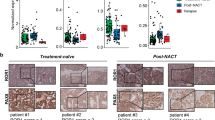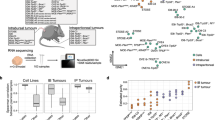Abstract
Mucin1 (MUC1) is an epithelial glycoprotein overexpressed in ovarian cancer and actively involved in tumor cell migration and metastasis. Using novel in vitro and in vivo MUC1-expressing conditional (Cre-loxP) ovarian tumor models, we focus here on MUC1 biology and the roles of Kras activation and Pten deletion during cell transformation and epithelial-to-mesenchymal transition (EMT). We generated several novel murine ovarian cancer cell lines derived from the ovarian surface epithelia (OSE) of mice with conditional mutations in Kras, Pten or both. In addition, we also generated several tumor-derived new cell lines that reproduce the original tumor phenotype in vivo and mirror late stage metastatic disease. Our results demonstrate that de novo activation of oncogenic Kras does not trigger increased proliferation, cellular transformation or EMT, and prevents MUC1 upregulation. In contrast, Pten deletion accelerates cell proliferation, triggers cellular transformation in vitro and in vivo, and stimulates MUC1 expression. Ovarian tumor-derived cell lines MKP-Liver and MKP-Lung cells reproduce in vivo EMT and represent the first immune competent mouse model for distant hematogenous spread. Whole genome microarray expression analysis using tumor and OSE-derived cell lines reveal a 121 gene signature associated with EMT and metastasis. When applied to n=542 cases from The Cancer Genome Atlas (TCGA) ovarian cancer dataset, the gene signature identifies a patient subset with decreased survival (P=0.04). Using an extensive collection of novel murine cell lines we have identified distinct roles for Kras and Pten on MUC1 and EMT in vivo and in vitro. The data has implications for future design of combination therapies targeting Kras mutations, Pten deletions and MUC1 vaccines.
This is a preview of subscription content, access via your institution
Access options
Subscribe to this journal
Receive 50 print issues and online access
$259.00 per year
only $5.18 per issue
Buy this article
- Purchase on Springer Link
- Instant access to full article PDF
Prices may be subject to local taxes which are calculated during checkout






Similar content being viewed by others
Accession codes
References
Nick AM, Coleman RL, Ramirez PT, Sood AK . A framework for a personalized surgical approach to ovarian cancer. Nat Rev Clin Oncol 2015; 12: 239–245.
Jayson GC, Kohn EC, Kitchener HC, Ledermann JA . Ovarian cancer. Lancet 2014; 384: 1376–1388.
Cormio G, Rossi C, Cazzolla A, Resta L, Loverro G, Greco P et al. Distant metastases in ovarian carcinoma. Int J Gynecol Cancer 2003; 13: 125–129.
Dauplat J, Hacker NF, Nieberg RK, Berek JS, Rose TP, Sagae S . Distant metastases in epithelial ovarian carcinoma. Cancer 1987; 60: 1561–1566.
Kerr VE, Cadman E . Pulmonary metastases in ovarian cancer. Analysis of 357 patients. Cancer 1985; 56: 1209–1213.
Davidson B, Trope CG, Reich R . Epithelial-mesenchymal transition in ovarian carcinoma. Front Oncol 2012; 2: 33.
Deng J, Wang L, Chen H, Li L, Ma Y, Ni J et al. The role of tumour-associated MUC1 in epithelial ovarian cancer metastasis and progression. Cancer Metastasis Rev 2013; 32: 535–551.
Dong Y, Walsh MD, Cummings MC, Wright RG, Khoo SK, Parsons PG et al. Expression of MUC1 and MUC2 mucins in epithelial ovarian tumours. J Pathol 1997; 183: 311–317.
Wang L, Ma J, Liu F, Yu Q, Chu G, Perkins AC et al. Expression of MUC1 in primary and metastatic human epithelial ovarian cancer and its therapeutic significance. Gynecol Oncol 2007; 105: 695–702.
Vlad AM, Kettel JC, Alajez NM, Carlos CA, Finn OJ . MUC1 immunobiology: from discovery to clinical applications. Adv Immunol 2004; 82: 249–293.
Zhang L, Vlad A, Milcarek C, Finn OJ . Human mucin MUC1 RNA undergoes different types of alternative splicing resulting in multiple isoforms. Cancer Immunol Immunother 2013; 62: 423–435.
McDermott KM, Crocker PR, Harris A, Burdick MD, Hinoda Y, Hayashi T et al. Overexpression of MUC1 reconfigures the binding properties of tumor cells. Int J Cancer 2001; 94: 783–791.
Besmer DM, Curry JM, Roy LD, Tinder TL, Sahraei M, Schettini J et al. Pancreatic ductal adenocarcinoma mice lacking mucin 1 have a profound defect in tumor growth and metastasis. Cancer Res 2011; 71: 4432–4442.
Yamamoto M, Bharti A, Li Y, Kufe D . Interaction of the DF3/MUC1 breast carcinoma-associated antigen and beta-catenin in cell adhesion. J Biol Chem 1997; 272: 12492–12494.
Carson DD . The cytoplasmic tail of MUC1: a very busy place. Sci Signal 2008; 1: pe35.
Kindelberger DW, Lee Y, Miron A, Hirsch MS, Feltmate C, Medeiros F et al. Intraepithelial carcinoma of the fimbria and pelvic serous carcinoma: Evidence for a causal relationship. Am J Surg Pathol 2007; 31: 161–169.
Cancer Genome Atlas Research N. Integrated genomic analyses of ovarian carcinoma. Nature 2011; 474: 609–615.
Mizuuchi H, Mori Y, Sato K, Kamiya H, Okamura N, Nasim S et al. High incidence of point mutation in K-ras codon 12 in carcinoma of the fallopian tube. Cancer 1995; 76: 86–90.
Roh MH, Yassin Y, Miron A, Mehra KK, Mehrad M, Monte NM et al. High-grade fimbrial-ovarian carcinomas are unified by altered p53, PTEN and PAX2 expression. Mod Pathol 2010; 23: 1316–1324.
Bellacosa A, de Feo D, Godwin AK, Bell DW, Cheng JQ, Altomare DA et al. Molecular alterations of the AKT2 oncogene in ovarian and breast carcinomas. Int J Cancer 1995; 64: 280–285.
Shayesteh L, Lu Y, Kuo WL, Baldocchi R, Godfrey T, Collins C et al. PIK3CA is implicated as an oncogene in ovarian cancer. Nat Genet 1999; 21: 99–102.
Obata K, Morland SJ, Watson RH, Hitchcock A, Chenevix-Trench G, Thomas EJ et al. Frequent PTEN/MMAC mutations in endometrioid but not serous or mucinous epithelial ovarian tumors. Cancer Res 1998; 58: 2095–2097.
Huang J, Zhang L, Greshock J, Colligon TA, Wang Y, Ward R et al. Frequent genetic abnormalities of the PI3K/AKT pathway in primary ovarian cancer predict patient outcome. Genes Chromosomes Cancer 2011; 50: 606–618.
Welsh JB, Zarrinkar PP, Sapinoso LM, Kern SG, Behling CA, Monk BJ et al. Analysis of gene expression profiles in normal and neoplastic ovarian tissue samples identifies candidate molecular markers of epithelial ovarian cancer. Proc Natl Acad Sci USA 2001; 98: 1176–1181.
Dinulescu DM, Ince TA, Quade BJ, Shafer SA, Crowley D, Jacks T . Role of K-ras and Pten in the development of mouse models of endometriosis and endometrioid ovarian cancer. Nat Med 2005; 11: 63–70.
Borowicz S, Van Scoyk M, Avasarala S, Karuppusamy Rathinam MK, Tauler J, Bikkavilli RK et al. The soft agar colony formation assay. J Vis Exp 2014; (92):e51998.
Budiu RA, Elishaev E, Brozick J, Lee M, Edwards RP, Kalinski P et al. Immunobiology of human mucin 1 in a preclinical ovarian tumor model. Oncogene 2013; 32: 3664–3675.
Baines AT, Xu D, Der CJ . Inhibition of Ras for cancer treatment: the search continues. Future Med Chem 2011; 3: 1787–1808.
Song MS, Salmena L, Pandolfi PP . The functions and regulation of the PTEN tumour suppressor. Nat Rev Mol Cell Biol 2012; 13: 283–296.
Domcke S, Sinha R, Levine DA, Sander C, Schultz N . Evaluating cell lines as tumour models by comparison of genomic profiles. Nat Commun 2013; 4: 2126.
Ince TA, Sousa AD, Jones MA, Harrell JC, Agoston ES, Krohn M et al. Characterization of twenty-five ovarian tumour cell lines that phenocopy primary tumours. Nat Commun 2015; 6: 7419.
Roby KF, Taylor CC, Sweetwood JP, Cheng Y, Pace JL, Tawfik O et al. Development of a syngeneic mouse model for events related to ovarian cancer. Carcinogenesis 2000; 21: 585–591.
Lengyel E, Burdette JE, Kenny HA, Matei D, Pilrose J, Haluska P et al. Epithelial ovarian cancer experimental models. Oncogene 2014; 33: 3619–3633.
Hasan N, Ohman AW, Dinulescu DM . The promise and challenge of ovarian cancer models. Transl Cancer Res 2015; 4: 14–28.
Horlings HM, Flanagan AM, Huntsman DG . Categorization of cancer through genomic complexity could guide research and management strategies. J Pathol 2015; 236: 397–402.
Horlings HM, Shah SP, Huntsman DG . Using Somatic Mutations to Guide Treatment Decisions: Context Matters. JAMA Oncol 2015; 1: 275–276.
Kufe DW . Mucins in cancer: function, prognosis and therapy. Nature Rev Cancer 2009; 9: 874–885.
Roy LD, Sahraei M, Subramani DB, Besmer D, Nath S, Tinder TL et al. MUC1 enhances invasiveness of pancreatic cancer cells by inducing epithelial to mesenchymal transition. Oncogene 2011; 30: 1449–1459.
Schroeder JA, Thompson MC, Gardner MM, Gendler SJ . Transgenic MUC1 interacts with epidermal growth factor receptor and correlates with mitogen-activated protein kinase activation in the mouse mammary gland. J Biol Chem 2001; 276: 13057–13064.
Jain N, Curran E, Iyengar NM, Diaz-Flores E, Kunnavakkam R, Popplewell L et al. Phase II study of the oral MEK inhibitor selumetinib in advanced acute myelogenous leukemia: a University of Chicago phase II consortium trial. Clin Cancer Res 2014; 20: 490–498.
Kandil E, Tsumagari K, Ma J, Abd Elmageed ZY, Li X, Slakey D et al. Synergistic inhibition of thyroid cancer by suppressing MAPK/PI3K/AKT pathways. J Surg Res 2013; 184: 898–906.
Paolo M, Assunta S, Antonio R, Claudia SP, Anna BM, Clorinda S et al. Selumetinib in advanced non small cell lung cancer (NSCLC) harbouring KRAS mutation: endless clinical challenge to KRAS-mutant NSCLC. Rev Recent Clin Trials 2013; 8: 93–100.
Iwanaga K, Yang Y, Raso MG, Ma L, Hanna AE, Thilaganathan N et al. Pten inactivation accelerates oncogenic K-ras-initiated tumorigenesis in a mouse model of lung cancer. Cancer Res 2008; 68: 1119–1127.
Du P, Kibbe WA, Lin SM . lumi: a pipeline for processing Illumina microarray. Bioinformatics 2008; 24: 1547–1548.
Ritchie ME, Phipson B, Wu D, Hu Y, Law CW, Shi W et al. Limma powers differential expression analyses for RNA-sequencing and microarray studies. Nucleic acids research 2015; 43: e47.
Acknowledgements
This study was partly supported by the Department of Defense (DOD) Ovarian Cancer Academy Award W81XWH-10-1-0525 and NIH/NCI R01 CA163462 (to AMV). Dr Vlad’s work has been funded by the NIH.
Author information
Authors and Affiliations
Corresponding author
Ethics declarations
Competing interests
The authors declare no conflict of interest.
Additional information
Supplementary Information accompanies this paper on the Oncogene website .
Rights and permissions
About this article
Cite this article
Zhang, L., Ma, T., Brozick, J. et al. Effects of Kras activation and Pten deletion alone or in combination on MUC1 biology and epithelial-to-mesenchymal transition in ovarian cancer. Oncogene 35, 5010–5020 (2016). https://doi.org/10.1038/onc.2016.53
Received:
Revised:
Accepted:
Published:
Issue Date:
DOI: https://doi.org/10.1038/onc.2016.53
This article is cited by
-
Metabolomic Pathway Activity with Genomic Single-Nucleotide Polymorphisms Associated with Colorectal Cancer Recurrence and 5-Year Overall Survival
Journal of Gastrointestinal Cancer (2023)
-
USP13 promotes development and metastasis of high-grade serous ovarian carcinoma in a novel mouse model
Oncogene (2022)
-
The multifaced role and therapeutic regulation of autophagy in ovarian cancer
Clinical and Translational Oncology (2022)
-
Upregulation of long noncoding RNA XIST has anticancer effects on ovarian cancer through sponging miR-106a
Human Cell (2021)
-
Stearoyl-CoA desaturase-1 promotes colorectal cancer metastasis in response to glucose by suppressing PTEN
Journal of Experimental & Clinical Cancer Research (2018)



